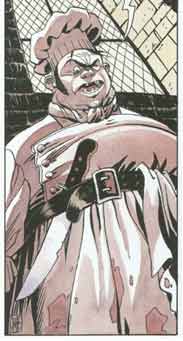|
Peake-plagiarism?

Please note: This page is mainly of interest to those who have read
Gormenghast (or saw the BBC-dramatization).
Martijn Adelmund, my editor at The Spectrum, the Dutch publisher of
Gormenghast, brought the comic strip Mister Black
to my attention. The text of this (not really comic) strip is by Jean Dufaux. The drawings are by
Griffo. "You should take a look at that book," Martijn said. "It has much the same
atmosphere as Gormenghast."
Of course, I followed his advice. When reading the story, however, I was seized by a
gradually mounting astonishment. It was not just a question of atmosphere. There was,
instead, an overwhelming number of similarities, too great to be coincidental -
even if Dufaux' story has almost nothing to do with that of Gormenghast.
 The location of this
story is an enormous castle (it grows, although).
The leading character of the story is an orphan girl, called Fanny. The castle is in
the keep of her warden, lord Charleston. The location of this
story is an enormous castle (it grows, although).
The leading character of the story is an orphan girl, called Fanny. The castle is in
the keep of her warden, lord Charleston.
Like lord Charleston, most of the characters' names refer to dances - a nice idea in
itself. But as we meet the castle's several inhabitants, an astonishing feeling of
déjà-vu makes itself felt. The hunchbacked valet by whom Fanny
is welcomed shows more resemblance with Frankensteins Igor than with Mr Flay, but
nevertheless gives rise to some suspicion. Soon a monstrous (but very familiar-looking)
chef makes his appearance. There is a friendly house teacher, who reminds us of Dr
Prunesquallor, and also a Lady Habanera, whose pet is a fat Siamese cat. If it
were not for the strong likeness between Fanny and Lewis Carroll's Alice, we would
feel tempted to see her as an alter ego of Peake's Fuchsia.
But the similarities don't end with that - nohow. At page 26 Fanny encounters a
strange youth, who is trespassing in her room. Four pages later, a bunch of nutty
professors enters the stage. Moreover, the population of this castle also is governed
by a quaint set of rules - not so much rituals as social
conventions, however.
 And so it goes on and on. Fanny receives lessons in a classroom which is as familiar as
Bellgroves sanctum. And by now it is hardly surprising to find that this
story also boasts a couple of twins - no feeble females, this time, but two malicious males,
called Mambo and Tango. Outside the castle walls we discover a population of paupers,
who receive food from the castle's inhabitants. And so it goes on and on. Fanny receives lessons in a classroom which is as familiar as
Bellgroves sanctum. And by now it is hardly surprising to find that this
story also boasts a couple of twins - no feeble females, this time, but two malicious males,
called Mambo and Tango. Outside the castle walls we discover a population of paupers,
who receive food from the castle's inhabitants.
There's really no end to this. The lord of the castle gets mad. The face of the
boy Twist (who already resembled Steerpike) is disfigured in a strange accident. There
is even a scene where two figures fall out of a window into the castle moat.
The drawings are beautiful in execution, some of them would even arouse rapture in
Gormenghast readers, were it not for the fact that this is such an overt case of
plagiarism. Dufaux (the last four letters of his name, meaning "false", are all
too appropriate) simply took over the "setting" of Mervyn Peakes Gormenghast,
and used it as the basis for his own cock-and-bull-story. In the process, he made
enough changes to make sure he could not legally persecuted for plagiarism.
But real Peake devotees know better, of course.
It would be an interesting endeavor to take a closer look at the other scenarios
by which Dufaux has gained his quite comfortable reputation, to see if this practice
is a standard procedure. On the other hand, it's no use throwing good after
bad money, seeing that I already spent eighty Dutch guilders on this fraud.
Still, if you're interested, Dufaux' bibliography can be found at
musky.et.tudelft.nl/sch-htm/dufaux.html
The artist Griffo (pseudonym for Werner Goelen) undoubtedly is as much of a copycat.
The visual correspondences between his drawings and the scenes evoked by Peake offer
more than eloquent evidence in this respect.

|

